– A photo story about a traditional craft –
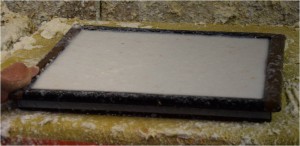 In the Romantic Age as well as today, high-quality watercolour-paper for artists is the so called wove paper ready-sized with gelatine. This paper is still produced at Two Rivers Paper Mill in Somerset, England. I went there to learn more about this traditional craft. You can read about my field trip to their workshop here.
In the Romantic Age as well as today, high-quality watercolour-paper for artists is the so called wove paper ready-sized with gelatine. This paper is still produced at Two Rivers Paper Mill in Somerset, England. I went there to learn more about this traditional craft. You can read about my field trip to their workshop here.
This is how the paper is made:
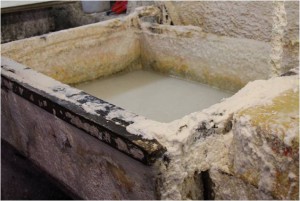 Beat cotton rags in water until they make a uniform textured pulp. This takes about 4 hours.
Beat cotton rags in water until they make a uniform textured pulp. This takes about 4 hours.
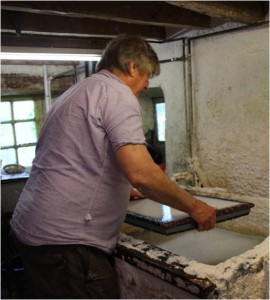 Take the mould, put the so called “deckle” (a kind of frame) on and agitate it horizontally in the pulp. The pulp gathers on the mesh of the mould. Lift the mould out of the water and allow the water to drain through the mesh. The water has to run slowly to allow the texture to settle. The slower this process is, the better the quality of the paper.
Take the mould, put the so called “deckle” (a kind of frame) on and agitate it horizontally in the pulp. The pulp gathers on the mesh of the mould. Lift the mould out of the water and allow the water to drain through the mesh. The water has to run slowly to allow the texture to settle. The slower this process is, the better the quality of the paper.
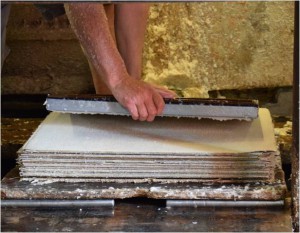 Turn the mould over onto a felt. The technical term for this is “crouching”. The texture of the felt gives its structure to the paper. During the Romantic Age, the process of filling the mould with pulp and crouching the sheet would have been done by two persons, making about 5-6 sheets of paper per minute.
Turn the mould over onto a felt. The technical term for this is “crouching”. The texture of the felt gives its structure to the paper. During the Romantic Age, the process of filling the mould with pulp and crouching the sheet would have been done by two persons, making about 5-6 sheets of paper per minute.
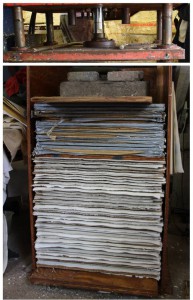 Press the crouched sheets four times to achieve the high-quality texture of the paper.
Press the crouched sheets four times to achieve the high-quality texture of the paper.
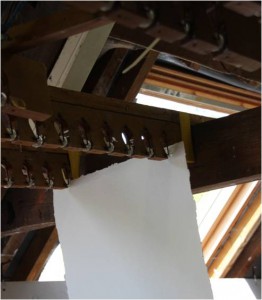 The final step in the process is sizing the surface with gelatine and slow air-drying the paper in the rafters of the mill loft.
The final step in the process is sizing the surface with gelatine and slow air-drying the paper in the rafters of the mill loft.
The new coated wove paper was in high demand by watercolour-artists in the Romantic Age. Read more about it in my post “A Traditional Craft: Making Watercolour-Paper” and also enjoy some plot bunnies that breed from it.
